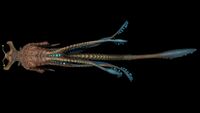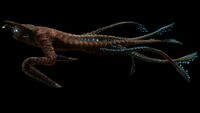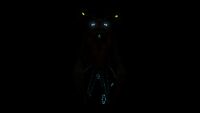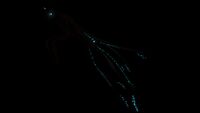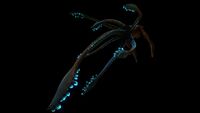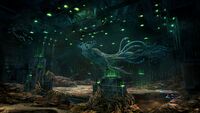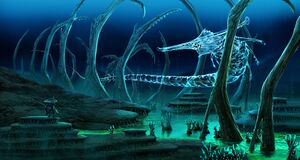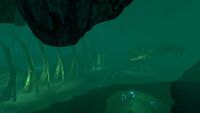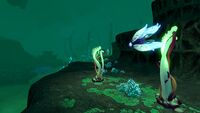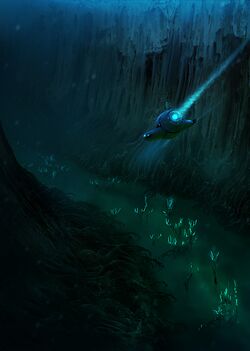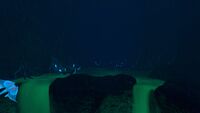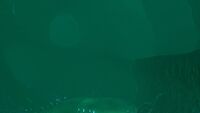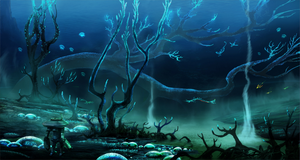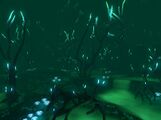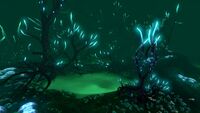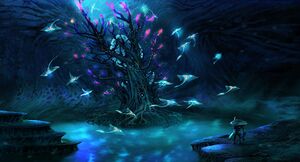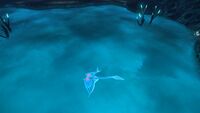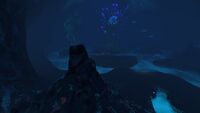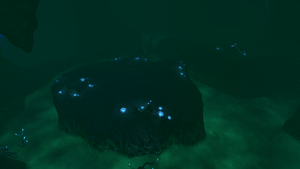User:ChrisFo/Testing: Difference between revisions
No edit summary Tag: sourceedit |
No edit summary Tag: sourceedit |
||
| Line 1: | Line 1: | ||
<tabber> |
|||
Captive Emperor= |
|||
{{SimilarName|the '''Sea Emperor'''|the [[Sea Emperor Juvenile]]}} |
|||
{{Class_2_Fauna|title1 = Sea Emperor|image1 = Sea Emperor Fauna.png|category = -|tab = [[Fauna]]|attitude = -|biome =[[Primary Containment Facility]] (unimplemented)|active_during = -|dna = |debug_spawn = <i>seaemperor}}{{Quote2|Of the specimens on record, only one survived infection with the Carar bacterium. The closest translation of their symbol for this specimen would be 'emperor'.|PDA|Data Downloads}}The '''Sea Emperor''' is an in-development [[Life Forms|life form]] belonging to the [[fauna]] category. It is still under development, and is only spawnable by using the [[Debug Console Commands]]. |
|||
Once fully implemented, the '''Sea Emperor''' will be the largest fauna in [[Subnautica]]. |
|||
== Appearance == |
|||
The '''Sea Emperor''' is colossal in size, having a stocky body entirely armored and predominantly pale brown in color, with a few shades of green. Its tentacles are adorned with bright cyan [[bioluminescent]] spots. |
|||
The creature's head is small, and quite peculiar in shape (see "''Trivia''" below for more), featuring two glowing green-tipped antennae on top of its snout, two large mandibles on each side of its rather small mouth, and a glowing hollow in-between these mandibles. It seems to possess four binocular eyes. |
|||
The '''Sea Emperor's''' posterior consists of seven long, yet slim tentacles ending with large tentacular clubs, with the largest being in the center, surrounded by the other smaller ones. |
|||
Unlike the [[Sea Dragon Leviathan]], the '''Sea Emperor''' doesn't have true graspers; Instead, its forelimbs are two massive, paddle-like arms. |
|||
==Behavior== |
|||
Despite its gargantuan size, the '''Sea Emperor's '''diet consists solely of micro-organisms filtered from the water. |
|||
It is suggested that in the past these creatures would have traveled in small herds, occasionally coming to the surface to feast on the microorganisms in the shallower water. When the [[Carar]] bacterium was released onto the planet, billions of creatures died, destroying the food source of the species. |
|||
== Story == |
|||
The captive '''Sea Emperor''' is the last remaining adult of its species. and a parent to [[Sea Emperor Eggs|five eggs]]. These eggs must be hatched at some point in the story. It is over one thousand years old, and is suggested to have far surpassed its natural lifespan. |
|||
Almost all of the '''Sea Emperors''' died when the [[Carar]] was released, leaving one remaining adult which was later discovered to be pregnant and laid five eggs. As the only source of [[Enzyme 42]] on [[Planet 4546B]], the '''Sea Emperor''' and its children are the key to curing Carar. |
|||
The last surviving '''Sea Emperor''' was studied by the [[Precursors]] in hopes of finding a cure using their natural production of [[Enzyme 42]]. However, due to their sickness, studies conducted showed that they were not a viable source of [[Enzyme 42]] as the enyzmes they produced were too unstable. Precursor documents state that they had "grown sick", and is later revealed that they were pregnant. After the '''Sea Emperor''' gave birth to five eggs, the [[Precursors]] took it's eggs and attached them to the [[Precursor Egg Incubator]], as the conditions of the aquarium were not suitable for it's eggs to hatch, and the juveniles may be a better source of [[Enzyme 42]]. Shortly after this, the [[Disease Research Facility]] was destroyed, releasing Carar, ending the Precursors' operation and initiating the planetary quarantine. The prison was originally all inorganic, sometime after the Precursors' operation failed, creatures indirectly brought seeds from [[Flora]] and loose sand and mud into the aquarium via the [[Precursor Teleporters|teleporters]] that led to the facility, transforming the aquarium into a thriving ecosystem. With the '''Sea Emperor''' producing enough [[Enzyme 42]] to keep the creatures inside immune. In turn, the creatures learned to protect the '''Sea Emperor''', this system kept a small amount of life on the planet living. |
|||
== Data Bank Entries == |
|||
{{#tag:tabber| |
|||
Data Bank Entry= |
|||
SPECIMEN SIZE CATEGORIES HAVE BEEN ADJUSTED UPWARD TO ACCOMMODATE THIS SPECIES |
|||
1. (Feeding & Digestion) |
|||
Despite its size this species subsists entirely on microorganisms it filters from the water. The mere presence of these microorganisms in such a restrictive environment is highly unlikely, depending as they do on a complicated ecosystem of plant and animal life. |
|||
2. (Reproduction) |
|||
Since just one adult specimen of this kind has been identified, it may reproduce asexually, but it may equally be the last of its kind. Large ovary-like organs are carried in the middle section, suggesting that like other species on this planet it produces eggs, however internal scar tissue indicates probable infertility. |
|||
3. (Stomach Enzyme) |
|||
The emperor is the only known source of a unique, complex enzyme which seems to play a pivotal role in protecting the ecosystem against the impacts of the bacterium. The indigenous creatures appear to have adapted to consume the enzyme in its natural form, when the emperor emits its stomach gases. However, the enzyme's structure is unstable, and they require a constant supply to stave off uncontrollable genetic mutation. |
|||
4. (Health) |
|||
Comparative analysis of size and metabolic rates indicates this specimen is more than 1,000 years old. Extensive internal and external scar tissue suggests it has lived well in excess of the peak lifespan for its species. |
|||
Assessment: Enzyme too unstable for cure. Enzyme synthesis impossible. One possibility left open: fully cure an individual with a more stable concentration of the enzyme, produced by a healthier specimen. |
|||
{{!}}-{{!}} |
|||
Life Cycle= |
|||
Available biological data has been used to synthesize the effects of the alien bacterium on the sea emperor's natural lifecycle. |
|||
This creature likely lived and moved in small herds around the planet's ocean trenches, coming to the surface to feed off the huge volumes of microorganisms in the shallower waters. Family size would be strictly limited by available food supply. Offspring would likely split off at a young age to form their own herds elsewhere. |
|||
Given their sparse population, mating and egg-laying was likely infrequent, perhaps a once in a lifetime event. The species likely had a preferred environment for egg-laying - in fact successful hatching may depend on such conditions. |
|||
There is no evidence to support the assumption that all members of the species were immune from the alien bacterium. Even if this is so, there is evidence that introduction of the bacterium decimated life on the planet, and this would have had catastrophic effects on the emperors' food supply and survival rate. |
|||
The symbiotic relationship between this specimen and other lifeforms likely developed as a direct result of the bacterial infection. Those lifeforms which learnt to keep the emperor alive survived with its help. This may explain the vast tracts of lifeless ocean in a rough perimeter around the emperor's location. |
|||
}} |
|||
== Future Plans == |
|||
*Juvenile '''Sea Emperors''' and '''Sea Emperor''' [[eggs]] will be added in the future.<ref>https://trello.com/c/l7XOXp0o/5508-baby-sea-emperor-scale-attempts''Dated June 22, 2016.''</ref> |
|||
*The '''Sea Emperor''' will produce [[Enzyme 42]] which will cure [[fauna]] and the [[Player]] of [[Carar]] |
|||
* The '''Sea Emperor''' may communicate telepathically with the Player about why they need to hatch its eggs.<ref>https://trello.com/c/XJ3CZkAa/5862-barebones-first-playable-story-spoilers</ref> |
|||
==Gallery== |
|||
{{#tag:tabber| |
|||
In Game Screenshots= |
|||
<gallery widths="200" spacing="small"> |
|||
Sea Emperor (Front-Black).jpg|Front view |
|||
Sea Emperor (Black)-1.jpg|Dorsal view |
|||
Sea Emperor (Black)-0.jpg|Side view |
|||
SeaEmperorD.jpg|[[Bioluminescence]] |
|||
SeaEmperorB.jpg|Ditto, side profile |
|||
SeaEmperor9.jpg|Rear view |
|||
</gallery> |
|||
{{!}}-{{!}} |
|||
Videos= |
|||
<gallery widths="200" spacing="small"> |
|||
Emp leviathan idle 01|Idle animation |
|||
Emp_leviathan_fixes_and_additions_03|More animations |
|||
</gallery> |
|||
{{!}}-{{!}} |
|||
Concept Art= |
|||
<gallery widths="200" spacing="small"> |
|||
B7355113857237.5632a8c44eea4.png|[[Concept Art]] |
|||
PrisonAquarium.jpg|The '''Sea Emperor''' inside the aquarium within the [[Primary Containment Facility]]. |
|||
</gallery> |
|||
}} |
|||
== Trivia == |
|||
* The '''Sea Emperor''' currently uses the AI of the [[Boneshark]] and lacks certain animations. It can attack, inflicting 80% damage to the player's health. |
|||
* Once fully implemented, the '''Sea Emperor''' will be upscaled to be larger than the [[Sea Dragon Leviathan]]<ref>http://imgur.com/ajtv3aP ''Date unknown.''</ref><ref>http://steamcommunity.com/app/264710/discussions/0/490123197954537523/ ''Dated October 18, 2015.''</ref> and it will become the largest life form in the game. |
|||
* Certain developmental notes refer to the '''Sea Emperor''' as the "Emperor Leviathan"<ref>https://trello.com/c/37zdy3CI/4561-emperor-leviathan-animations ''Dated June 16, 2015.''</ref>. |
|||
** Various documents also refer to the '''Sea Emperor''' as the "Grand Leviathan". |
|||
* The '''Sea Emperor''' closely shares many of its features to real life animals: a head shape slightly similar to that of many [https://en.wikipedia.org/wiki/Hammerhead_shark hammerhead sharks], and paddle-like arms, resembling those of the [https://en.wikipedia.org/wiki/Green_sea_turtle green sea turtles]. |
|||
* The databank entry suggests that the last surviving '''Sea Emperor''' was kept alive well beyond its natural lifespan using unknown technologies, leaving heavy internal and external scarring (possibly even having led to its suggested infertility). |
|||
* The '''Sea Emperor''' is named after the closest translation the [[PDA]] could find for a [[Precursors|Precursor]] symbol. This technically makes it the only creature not named by the [[Player]]/PDA. |
|||
* The opening sentence of the data bank entry suggests that '''Sea Emperors''' are the largest identified species in the Subnautica universe. |
|||
== References == |
|||
<references /> |
|||
{{Navbox Fauna}} |
|||
|-| |
|||
Normal Emperor= |
|||
PUT TEXT HERE! |
|||
</tabber> |
|||
<div class="mw-collapsible mw-collapsed"> |
|||
=TOC Test= |
=TOC Test= |
||
| Line 390: | Line 512: | ||
|group4 = In Development |
|group4 = In Development |
||
|list4 = [[Mohawk]] • [[Spike Trap]]}} |
|list4 = [[Mohawk]] • [[Spike Trap]]}} |
||
</div> |
|||
Revision as of 17:42, 23 February 2017
<tabber> Captive Emperor=
Of the specimens on record, only one survived infection with the Carar bacterium. The closest translation of their symbol for this specimen would be 'emperor'.
― PDA, Data Downloads
The Sea Emperor is an in-development life form belonging to the fauna category. It is still under development, and is only spawnable by using the Debug Console Commands.
Once fully implemented, the Sea Emperor will be the largest fauna in Subnautica.
Appearance
The Sea Emperor is colossal in size, having a stocky body entirely armored and predominantly pale brown in color, with a few shades of green. Its tentacles are adorned with bright cyan bioluminescent spots.
The creature's head is small, and quite peculiar in shape (see "Trivia" below for more), featuring two glowing green-tipped antennae on top of its snout, two large mandibles on each side of its rather small mouth, and a glowing hollow in-between these mandibles. It seems to possess four binocular eyes.
The Sea Emperor's posterior consists of seven long, yet slim tentacles ending with large tentacular clubs, with the largest being in the center, surrounded by the other smaller ones.
Unlike the Sea Dragon Leviathan, the Sea Emperor doesn't have true graspers; Instead, its forelimbs are two massive, paddle-like arms.
Behavior
Despite its gargantuan size, the Sea Emperor's diet consists solely of micro-organisms filtered from the water.
It is suggested that in the past these creatures would have traveled in small herds, occasionally coming to the surface to feast on the microorganisms in the shallower water. When the Carar bacterium was released onto the planet, billions of creatures died, destroying the food source of the species.
Story
The captive Sea Emperor is the last remaining adult of its species. and a parent to five eggs. These eggs must be hatched at some point in the story. It is over one thousand years old, and is suggested to have far surpassed its natural lifespan.
Almost all of the Sea Emperors died when the Carar was released, leaving one remaining adult which was later discovered to be pregnant and laid five eggs. As the only source of Enzyme 42 on Planet 4546B, the Sea Emperor and its children are the key to curing Carar.
The last surviving Sea Emperor was studied by the Precursors in hopes of finding a cure using their natural production of Enzyme 42. However, due to their sickness, studies conducted showed that they were not a viable source of Enzyme 42 as the enyzmes they produced were too unstable. Precursor documents state that they had "grown sick", and is later revealed that they were pregnant. After the Sea Emperor gave birth to five eggs, the Precursors took it's eggs and attached them to the Precursor Egg Incubator, as the conditions of the aquarium were not suitable for it's eggs to hatch, and the juveniles may be a better source of Enzyme 42. Shortly after this, the Disease Research Facility was destroyed, releasing Carar, ending the Precursors' operation and initiating the planetary quarantine. The prison was originally all inorganic, sometime after the Precursors' operation failed, creatures indirectly brought seeds from Flora and loose sand and mud into the aquarium via the teleporters that led to the facility, transforming the aquarium into a thriving ecosystem. With the Sea Emperor producing enough Enzyme 42 to keep the creatures inside immune. In turn, the creatures learned to protect the Sea Emperor, this system kept a small amount of life on the planet living.
Data Bank Entries
<tabber> Data Bank Entry=
SPECIMEN SIZE CATEGORIES HAVE BEEN ADJUSTED UPWARD TO ACCOMMODATE THIS SPECIES
1. (Feeding & Digestion)
Despite its size this species subsists entirely on microorganisms it filters from the water. The mere presence of these microorganisms in such a restrictive environment is highly unlikely, depending as they do on a complicated ecosystem of plant and animal life.
2. (Reproduction)
Since just one adult specimen of this kind has been identified, it may reproduce asexually, but it may equally be the last of its kind. Large ovary-like organs are carried in the middle section, suggesting that like other species on this planet it produces eggs, however internal scar tissue indicates probable infertility.
3. (Stomach Enzyme)
The emperor is the only known source of a unique, complex enzyme which seems to play a pivotal role in protecting the ecosystem against the impacts of the bacterium. The indigenous creatures appear to have adapted to consume the enzyme in its natural form, when the emperor emits its stomach gases. However, the enzyme's structure is unstable, and they require a constant supply to stave off uncontrollable genetic mutation.
4. (Health)
Comparative analysis of size and metabolic rates indicates this specimen is more than 1,000 years old. Extensive internal and external scar tissue suggests it has lived well in excess of the peak lifespan for its species.
Assessment: Enzyme too unstable for cure. Enzyme synthesis impossible. One possibility left open: fully cure an individual with a more stable concentration of the enzyme, produced by a healthier specimen.
|-|
Life Cycle= Available biological data has been used to synthesize the effects of the alien bacterium on the sea emperor's natural lifecycle.
This creature likely lived and moved in small herds around the planet's ocean trenches, coming to the surface to feed off the huge volumes of microorganisms in the shallower waters. Family size would be strictly limited by available food supply. Offspring would likely split off at a young age to form their own herds elsewhere.
Given their sparse population, mating and egg-laying was likely infrequent, perhaps a once in a lifetime event. The species likely had a preferred environment for egg-laying - in fact successful hatching may depend on such conditions.
There is no evidence to support the assumption that all members of the species were immune from the alien bacterium. Even if this is so, there is evidence that introduction of the bacterium decimated life on the planet, and this would have had catastrophic effects on the emperors' food supply and survival rate.
The symbiotic relationship between this specimen and other lifeforms likely developed as a direct result of the bacterial infection. Those lifeforms which learnt to keep the emperor alive survived with its help. This may explain the vast tracts of lifeless ocean in a rough perimeter around the emperor's location.
</tabber>
Future Plans
- Juvenile Sea Emperors and Sea Emperor eggs will be added in the future.[1]
- The Sea Emperor will produce Enzyme 42 which will cure fauna and the Player of Carar
- The Sea Emperor may communicate telepathically with the Player about why they need to hatch its eggs.[2]
Gallery
<tabber> In Game Screenshots=
|-| Videos=
- Emp leviathan idle 01
Idle animation
- Emp leviathan fixes and additions 03
More animations
|-| Concept Art=
The Sea Emperor inside the aquarium within the Primary Containment Facility.
</tabber>
Trivia
- The Sea Emperor currently uses the AI of the Boneshark and lacks certain animations. It can attack, inflicting 80% damage to the player's health.
- Once fully implemented, the Sea Emperor will be upscaled to be larger than the Sea Dragon Leviathan[3][4] and it will become the largest life form in the game.
- Certain developmental notes refer to the Sea Emperor as the "Emperor Leviathan"[5].
- Various documents also refer to the Sea Emperor as the "Grand Leviathan".
- The Sea Emperor closely shares many of its features to real life animals: a head shape slightly similar to that of many hammerhead sharks, and paddle-like arms, resembling those of the green sea turtles.
- The databank entry suggests that the last surviving Sea Emperor was kept alive well beyond its natural lifespan using unknown technologies, leaving heavy internal and external scarring (possibly even having led to its suggested infertility).
- The Sea Emperor is named after the closest translation the PDA could find for a Precursor symbol. This technically makes it the only creature not named by the Player/PDA.
- The opening sentence of the data bank entry suggests that Sea Emperors are the largest identified species in the Subnautica universe.
References
- ↑ https://trello.com/c/l7XOXp0o/5508-baby-sea-emperor-scale-attemptsDated June 22, 2016.
- ↑ https://trello.com/c/XJ3CZkAa/5862-barebones-first-playable-story-spoilers
- ↑ http://imgur.com/ajtv3aP Date unknown.
- ↑ http://steamcommunity.com/app/264710/discussions/0/490123197954537523/ Dated October 18, 2015.
- ↑ https://trello.com/c/37zdy3CI/4561-emperor-leviathan-animations Dated June 16, 2015.
Lua error in package.lua at line 80: module 'Dev:Navbox' not found.
|-| Normal Emperor= PUT TEXT HERE! </tabber>
TOC Test
| Contents | 0–9 A B C D E F G H I J K L M N O P Q R S T U V W X Y Z |
|---|
| Contents: | 0–9 · A · B · C · D · E · F · G · H · I · J · K · L · M · N · O · P · Q · R · S · T · U · V · W · X · Y · Z |
|---|
Add tabbers into a box
Description
The Lost River is generally gloomy and foggy, possessing a distinct greenish water tint that is mostly illuminated by acidic brine pools. These pools cover almost all of the lower portions of the caverns. The green brine found throughout most of the cave system will harm the player, but the blue brine found within the Tree Cove is harmless.
The Disease Research Facility is located in the Lost River, inside a cavern.
The Lost River is composed of five distinct areas:
<tabber> Bones Field=
The Bones Field is a vast cavern within the Lost River, where a massive skeleton of an unknown fauna can be seen laying. It connects to the first Blood Kelp Zone, through passages, each of them having its own flora and particular landscape, as well as the Ghost Canyon.
<tabber> Fauna=
|-|
Flora=
|-|
Resources=
</tabber>Gallery
Some Ghost Weeds and a Mesmer inside the Bones Field
|-|
Ghost Canyon=
The Ghost Canyon is a huge passage featuring multiple caves and tunnels branching out from one main canyon. It connects to the Bones Field from the south. Numerous roots and luminescent-tipped branches litter the sides and bottom of the brine-filled trenches.
Gallery
View of the entrance from the Ghost Canyon to the Deep Grand Reef
|-|
Ghost Forest=
A large chamber that leads from the main entrance of the Lost River (located in the second Blood Kelp Zone). This area is filled with whitish glowing blobs and dark brown, bioluminescent giant Ghost Trees, and is also the starting point of the brine river. From there, the player can either go straight forward into the Bones Field, or turn right to enter the Tree Cove. Brinefalls of various sizes are present, and a smaller version of the skull found in the Bones Field can be found here.<tabber>
Fauna=
|-|
Resources=
</tabber>Gallery
A small brine pool, notice the River Prowler
|-|
Tree Cove=
The Tree Cove is a large cavern within the Lost River. The brine river forms a large lake there, with the luminous Giant Cove Tree in its center. However, the color of the brine is a bright blue, compared to the green brine of the other sections of the Lost River One end opens to the north tunnel leading to the Bones Field, and the other, a corridor, to the Inactive Lava Zone. Roots and branches grow scattered on the brine-lake and numerous Ghostrays inhabit the chamber.<tabber>
Fauna=
|-|
Flora=
|-|
Resources=
</tabber>Gallery
A Ghostray under the blue brine
|-| Junction=
The Junction is characterised by a large plateau surrounded by a ring of brine. At the top of the plateau are several smokers, and a few glowing blobs. A naturally formed bridge connects the plateau to the northern side of the cavern, towards the Ghost Forest. Brinefalls from the north and south flow into the brine here, which contains some ghost trees and roots. The Junction connects to the Bones Field to the south, the Ghost Forest to the north, the Disease Research Facility's cavern to the east, and the Tree Cove to the west.<tabber>
Fauna=
|-|
Resources=
</tabber>Gallery
<gallery widths="200" spacing="small"> Junction-Overview.jpg|Overview Junction-Bridge.jpg|A naturally formed bridge, connecting the plateau to another side of the Junction Junction-Smoker.jpg|Some smokers nearby the Disease Research Facility cave entrance </tabber>
To Do:
- Add Navboxes to the sites
- Navbox items upgrade modules, in development, seabase modules is missing
- Alphabetical order
- in all lists, too
- Check with Blueprints
- Check all Navboxes before adding new Navboxes
- what about floodlight and light stick and other light in seabase modules
- add interior, exterior modules, ...
- add categorys for flora, biomes
Fauna ✓
Lua error in package.lua at line 80: module 'Dev:Navbox' not found.
Biomes ✓
Lua error in package.lua at line 80: module 'Dev:Navbox' not found.
Items
Lua error in package.lua at line 80: module 'Dev:Navbox' not found.
Corals ✓
Lua error in package.lua at line 80: module 'Dev:Navbox' not found.
Seabase Modules ✓
Lua error in package.lua at line 80: module 'Dev:Navbox' not found.
Flora ✓
Lua error in package.lua at line 80: module 'Dev:Navbox' not found.


